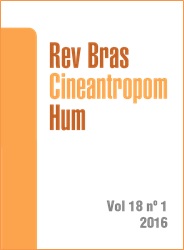Biomechanical analysis of the contact phase in drop jumps performed in water and on dry land
DOI:
https://doi.org/10.1590/1980-0037.2016v18n1p41Abstract
Plyometric training in the aquatic environment has been used as way of reducing loads through the action of buoyancy. However, little is known about the biomechanical characteristics of plyometric exercises in water, which can assist in the prescription of training in this environment. This study aimed to analyze the vertical component of the ground reaction force and contact duration of drop jumps (DJ) performed on land and at hip level water immersion. Participants were 22 male athletes (19.1 ± 3.7 years), who performed three maximum DJs in water and on dry land. Peak force and duration of braking and propulsion sub-phases of the DJ contact were analyzed with the use of two underwater force platforms, a 2-D waterproofed electrogoniometer, acquisition systems ADS2000-IP and TeleMyo 2400TG2, and a signal synchronizer. The effect of immersion was investigated through comparison tests for dependent samples (p <0.05). In water, the following results were observed: (a) reduction of 41.8% (p <0.001, d = 2.24) and 23.8% (p <0.001, d = 1.50) of peak forces during braking and propulsion sub-phases respectively; and (b) increase of 41.8% in the braking (p <0.001, d = 1.41) and 12.3% in the propulsion contact times (p = 0.006, d = 0.75). The aquatic environment can be an alternative when one aims to reduce the load during the DJ contact; however, the longer duration increasing of contact sub-phases in water at hip immersion may compromise the proper functioning of the stretch-shortening cycle in water.



